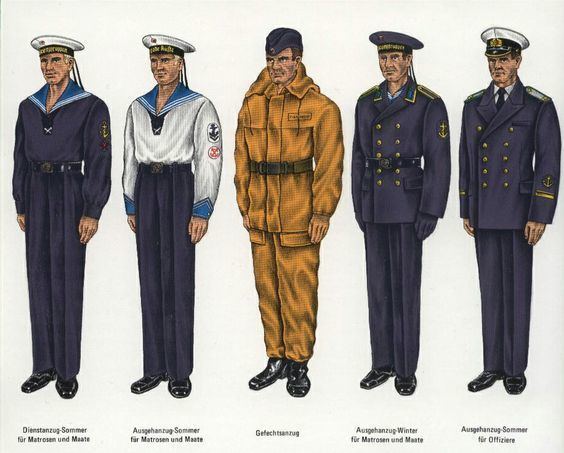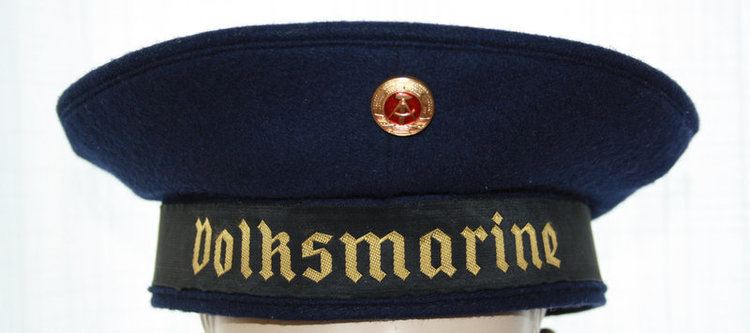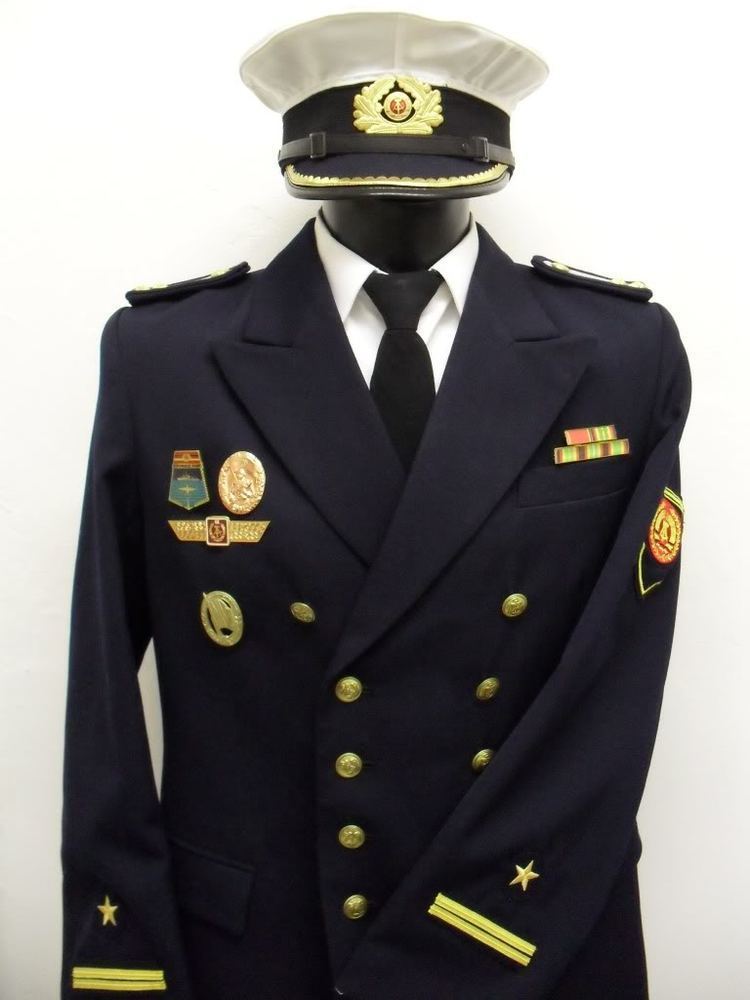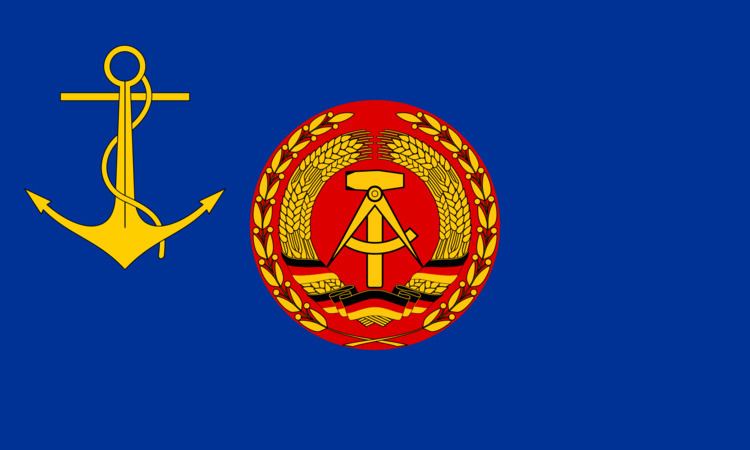Active 1956–1990 Type Navy Size 27,300 personnel | Founded 1 March 1956 | |
 | ||
Allegiance National Defence Council Similar National People's Army, Air Forces of the National, Border Troops of the Germ, German Navy, Land Forces of the Natio | ||
Pr sentiermarsch der volksmarine
The Volksmarine - VM ( [ˈfɔlksmaˌʁiːne]; English: People's Navy), was the official designation of the naval forces of the German Democratic Republic (GDR). It was part of the National People's Army, established on 1 March 1956.
Contents
- Pr sentiermarsch der volksmarine
- Kleines raketenschnellboot 1241
- History
- Operative tasks
- Commanders
- Organization
- Material
- Music
- Volksmarine admirals
- Flottenadmiral
- Admiral
- Vizeadmiral
- Konteradmiral
- References

Kleines raketenschnellboot 1241
History

Soon after the end of World War II and the beginning of the Cold War the Soviet Union initiated the rearming of its satellite state in East Germany. This included the gradual formation of maritime forces.

Beginning in 1950, Soviet naval officers helped to establish the Hauptverwaltung Seepolizei (Main Administration Sea Police), which was renamed Volkspolizei–See (VP–See) (People's Police – Sea) on 1 July 1952. At the same time parts of the erstwhile maritime police were reorganized into the new Grenzpolizei–See (Border Police –– Sea), to guard the sea frontiers, and incorporated into the Deutsche Grenzpolizei (German Border Police) that had been set up in 1946. By 1952 the VP–See is estimated to have numbered some 8,000 personnel.

On 1 March 1956, the GDR formally created its Nationale Volksarmee (NVA) (National People's Army), and the VP–See became the Verwaltung Seestreitkräfte der NVA (Maritime Forces Administration of the NVA) with about 10,000 men. In November 1960, these maritime forces of the National People's Army were officially designated Volksmarine (People's Navy). Over the next years the navy gradually received a number of new ships, mostly built in the GDR. Only the coastal protection ships and some of the fast torpedo boats were provided by the Soviet Union, as were all helicopters, and some auxiliary craft were purchased from Poland.

Following the building of the Berlin Wall on 13 August 1961 the Grenzbrigade Küste der Grenzpolizei (GBK) (Coastal Border Brigade of the Border Police) was incorporated into the People's Navy. With the reorganization of 1965 all attack forces, i.e., the fast torpedo boats, were combined into a single flotilla (the 6th Flotilla) and stationed on the Bug peninsula of the island of Rügen. In the 1970s the People's Navy had grown to about 18,000 men. In the 1980s some of the ships were replaced and the People's Navy acquired Soviet-built fighter-bombers.
In 1988, the People's Navy had brief hostile confrontations with Polish naval forces over a maritime border dispute; in subsequent negotiations about two thirds of the disputed maritime area were allocated to the GDR.

The People's Navy was dissolved, like all other branches of the former National People's Army, on 2 October 1990 – the day before the official reunification of Germany. Some of its staff was assumed into the Bundesmarine (which was henceforth called Deutsche Marine), some by the German Border Police. Most of the ships and other equipment were scrapped or sold, and few if any former People's Navy vessels remain in service with the modern-day German Navy. The last commander of the People's Navy, Vizeadmiral Hendrik Born, wrote a multi-paragraph commentary for Dieter Flohr and Peter Seemann's 2009 book, Die Volksmarine, a comprehensive and picture-oriented history of the People's Navy.
Operative tasks
The People's Navy was operationally incorporated into the United Baltic Sea Fleets of the Warsaw Pact states. Its designated area of operations was the Baltic Sea and the entrances to the Baltic Sea. Its task was to keep the sea lanes open for Soviet reinforcements and to participate in offensive actions against the coasts of hostile nations in the Baltic Sea. For these purposes, it was equipped with light forces such as anti-submarine ships, fast torpedo boats, minesweepers as well as landing craft. Routine duty was heavily focused on extensive reconnaissance activities, carried out mainly by the minesweepers and specialized electronic surveillance boats.
The 6th Border Brigade (Coast) had a special responsibility for the prevention of ″republikflucht″ (people leaving the GDR without official permission). With effect from 1 November 1961 it was subordinated to the People's Navy. It had a substantial number of small patrol boats and surveillance posts along the coast.
Commanders
Organization
The People's Navy was headed by the Kommando der Volksmarine (People's Navy HQ Command) in Rostock-Gehlsdorf. It was structured as follows (in 1985):
In addition there were:
Material
The People's Navy was equipped with:
Music
The People's Navy's band played a number of specially-composed musical pieces. Most notable is "Präsentiermarsch der Volksmarine", which was composed by Ludwig Schmidt for use at ceremonial events. "Unsere Volksmarine" was also written for use at parades. The instrumental pieces written for the People's Navy fell out of use after the reunification of Germany, and are not used by the modern German Navy.
Volksmarine admirals
There were 37 Admirals in the history of the Volksmarine and its predecessor organizations. They were:
